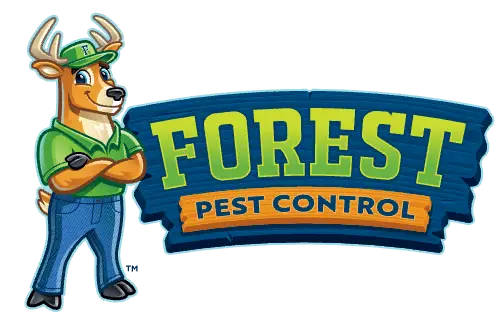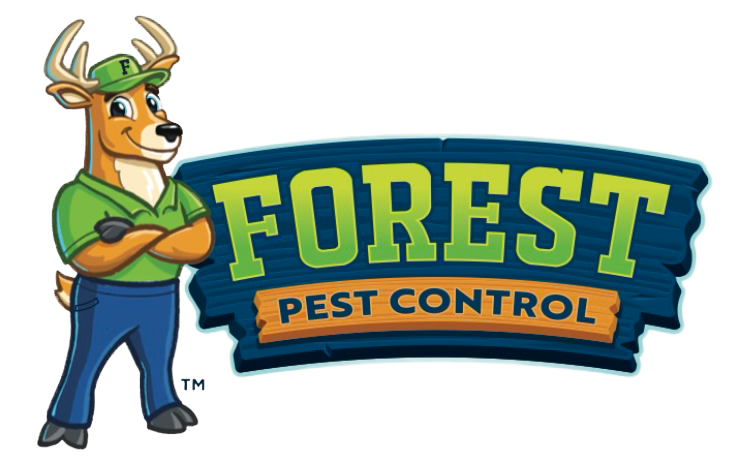Common Types of Ants in Florida

Florida’s warm, humid climate offers the perfect environment for a wide variety of ant species. From tiny kitchen invaders to large colonies in your yard, ants can become a serious nuisance if left unchecked. But there’s good news. By knowing which ants you’re up against, you’re in a much better position to prevent the next infestation or quickly eliminate it.
Below you will find a list of the most common ants in Florida. This isn’t an exhaustive catalog — Florida is home to many ant species — but these are the ones you’re most likely to run across.
Big-headed ant
Fire ant
Ghost ant
Argentine ant
Carpenter ant
Pavement ant
Pharaoh ant
Tawny crazy ant
Thief ant
Acrobot ant
What Are the Most Common Ants in Florida?
Let’s talk about common ants in our state, their habits and habitats, and steps you can take to keep them away from your home or business.
Fire Ant
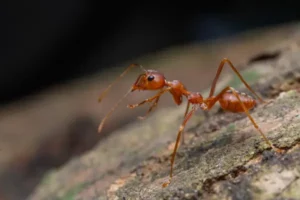 Identification: Typically 1/8” to 1/4” long, with a reddish-brown head and thorax and a darker abdomen. Known for their aggressive behavior and painful sting.
Identification: Typically 1/8” to 1/4” long, with a reddish-brown head and thorax and a darker abdomen. Known for their aggressive behavior and painful sting.
Where to Find: Build large mound-like nests in open, sunny areas such as lawns, fields, and near sidewalks or driveways.
“Fun” Fact: Their sting can leave a painful welt; if the nest is disturbed, they swarm quickly.
Ghost Ant
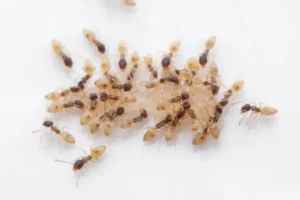 Identification: Extremely small, about 1/16” long, with a dark head/thorax and a pale, almost translucent abdomen and legs.
Identification: Extremely small, about 1/16” long, with a dark head/thorax and a pale, almost translucent abdomen and legs.
Where to Find: Often indoors—especially in kitchens and bathrooms—nesting in wall voids, behind baseboards, or even in potted plants.
“Fun” Fact: Their name comes from their “disappearing” act; because their abdomen and legs are so light in color, you’ll often see just the darker head.
Argentine Ant
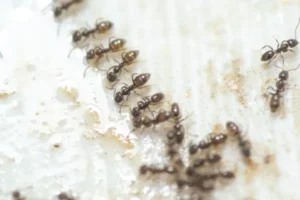 Identification: About 1/8” long, light to dark brown, with a slender body and one small node connecting the thorax and abdomen.
Identification: About 1/8” long, light to dark brown, with a slender body and one small node connecting the thorax and abdomen.
Where to Find: Thrive in moist areas (potted plants, mulch) and form extensive trails indoors along edges and corners while foraging for food.
“Fun” Fact: They can create massive “supercolonies,” with multiple queens and interconnected nests spanning large areas.
Carpenter Ant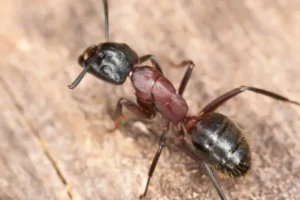
Identification: One of the largest ant species, typically 1/4” to 1/2” long. Usually black, or a combination of black and red.
Where to Find: Frequently nests in moist or decaying wood, such as tree stumps, eaves, or attics. They bore through wood to create galleries but do not eat it.
“Fun” Fact: Named for their woodworking habit, which can lead to structural damage when colonies go undetected.
Pavement Ant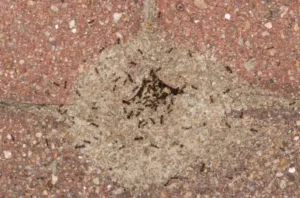
Identification: About 1/8” long, generally dark brown to black. Noticeable parallel lines on the head and thorax, plus two small spines at the rear of the thorax.
Where to Find: Commonly nest under sidewalks, driveways, and building foundations. Can enter buildings through tiny cracks at ground level.
“Fun” Fact: They occasionally engage in large “turf wars” with neighboring colonies—sometimes battling en masse on sidewalks.
Pharaoh Ant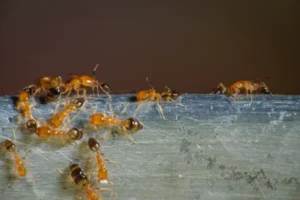
Identification: Very small (around 1/16” long), light yellow to reddish in color. Abdomen may look slightly translucent.
Where to Find: Popular indoor pests in warm, humid spots (kitchens, bathrooms, pantries), nesting in wall voids or under appliances.
“Fun” Fact: Known to “bud” their colonies when threatened; groups of workers and a queen will split off to form new colonies elsewhere.
Tawny Crazy Ant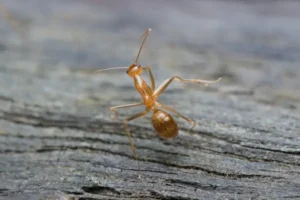
Identification: About 1/8” long, golden-brown, with an erratic, fast-moving foraging pattern — hence the “crazy” name.
Where to Find: Prefers moist, warm environments under rocks, mulch, or yard debris; can invade homes in search of food.
“Fun” Fact: Their sprawling colonies can grow incredibly quickly, often overwhelming an area in a short amount of time.
Acrobot Ant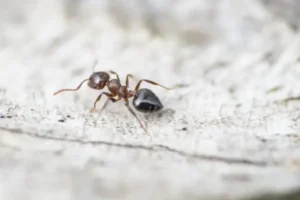
Identification: About 1/8” to 1/4” long, varying from light brown to black. Known for raising their heart-shaped abdomen above their thorax when threatened.
Where to Find: Commonly nests in decaying wood, tree stumps, or damp areas indoors. Trails may run along utility lines or tree branches that touch buildings.
“Fun” Fact: Their “acrobat” posture is a defensive display — hence the name.
Big-Headed Ant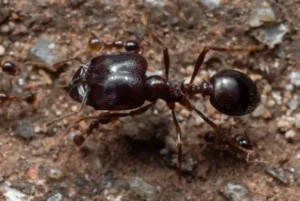
Identification: Typically 1/16” to 1/8” long. Major workers (or “soldiers”) have an oversized head that sets them apart from the smaller minor workers.
Where to Find: Build small mounds in soil, often under rocks or in lawns. Can sneak into homes through cracks near the foundation.
“Fun” Fact: Soldiers use their large heads for defense, while the minor workers focus on foraging and caring for the colony.
Are Termites Ants?
No — termites are not ants, although it’s easy to mistake the two at first glance, especially here in Florida where both pests thrive in our warm, humid climate. While ants and termites can have wings and appear in large swarms, there are a few clear ways to tell them apart:
Body Shape: Termites have a more uniform body thickness (sometimes described as a “thick waist”), while ants have a narrow, pinched waist.
Antennae: Termite antennae are straight or slightly curved, whereas ants have elbowed antennae.
Wings (if present): Winged termites (alates) have two pairs of wings of equal length. Winged ants also have two pairs, but the front wings are noticeably longer than the hind wings.
For more information, be sure to check out our termite control page.
Need Help with an Ant Infestation?
We’re Forest Pest Control – a local Florida pest control company – and we have extensive experience helping homes and businesses solve ant problems. Our exterminators provide proven ant control solutions and follow-up services to ensure your space remains free of unwanted pests.
No matter which species of ant is bugging you, the professionals at Forest Pest Control can help. Call us today for a free estimate and let’s put an end to your ant problems!

Ready To Schedule Service?
Leave us your information below and we will get right back to you.
